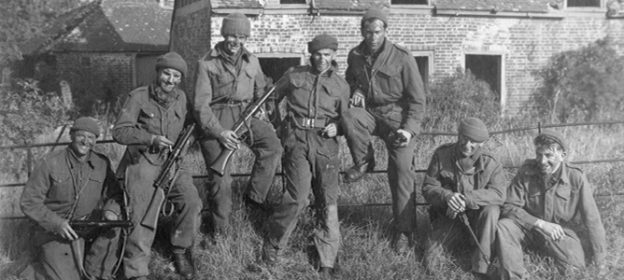Once again we had a beautiful day for our visit to Coleshill to see the site of the wartime training area for “Auxiliers”, whose function would have been to form a resistance force
in the event that the German invasion had succeeded.
We were met by Liza Dibble the NT Community Learning Officer, and given a short introduction to the estate. It is a largely agricultural area with 11 tenanted farms, three of which are organic dairies, with approximately 400 acres of woodland.
The first ideas for this unit were discussed as early as 1937 and by 1940, with Hitler threatening invasion with Operation Sealion the unit was set up. It was decided that people should be trained centrally and Coleshill was chosen as a suitable site. The house was then occupied by 2 elderly ladies and it was thought that the site could be easily concealed and kept secret while also having easy access to the rail network.
Trainees were hand-picked and known as ‘Auxiliers’. – Many were recruited from the farming and gamekeeping communities because of the skills they already possessed. Our first stop was at the guard house beside the road which still exists in its original form. This is open to the public and contains several information boards and also a recording of one of the original trainees recruited as a boy of 17 who when asked if he was ever afraid said “When you are 17
you are invincible”. The guard house was well protected by trees so would not have been visible from the air.
The Unit was commanded by Col. Mike Gubbins and many of the recruits were veterans of the First World War or too young to be called up for the Second. We saw a map of the expected lines of attack in the event of invasion, and the code name for the Defence Operation was to be “Cromwell”. Each patrol had their own base unknown to any other for security reasons. About 3000 men in total were recruited, spread over the country. By December 1944 when it became clear they would not be needed the units were stood down, with instructions to destroy their operational bases, but this was not always obeyed. They were never awarded medals or officially acknowledged.
We were given fascinating details of the equipment and instruction booklets issued to each man. Equipment included a garrotting wire and commando knife as well as a revolver and sniper rifle. They were also issued with very advanced radios, none of which now exist even at Bletchley Park. The pamphlets were given covers designed to conceal the true nature of their contents, which included instructions on self-defence, weapon handling and explosives. One booklet was entitled “Highworth Fertilizers”.
We also learned something of the original 17th century house which was destroyed by fire in 1952. A garden now marks the ground plan. The personnel involved in these units were all men, with the exception of 2 very skilled women radio operators known as “Secret Sweeties”.
The next stage of the visit involved a fairly lengthy walk through woodland to the site of the actual training base, which had been examined exhaustively by an archaeological team. This consisted of an underground bunker replicating the bases from which the men would operate. It was entered via a concealed shaft with a ladder, there was a lavatory area and a blast barrier to provide a limited protection in the event of a grenade attack. There were also the remains of bed bases which could have accommodated 8 men, and also a storage area. We entered and left via the escape tunnel which would have given access into the Ha-Ha by dislodging blocking stones. There was a ventilation shaft disguised in the form of a tree, which would also have removed smells.
We were also shown concrete bases of accommodation blocks used for the trainees who came down for long weekend sessions. And our guide pointed out a number of mysterious holes in the ground, which she said were known as “sites of indeterminate use”(ie no-one knew what they were for).
At the end of our walk back we were able to enjoy the glorious views over the fields and woodland to the White Horse in the far distance. We were also shown some very moving plaques on some of the trees commemorating men who had trained on the site and later lost their lives when they had moved on to other wartime service.
We were very much indebted to Liza for her very well-informed and enjoyable tour.
Janet Taylor

